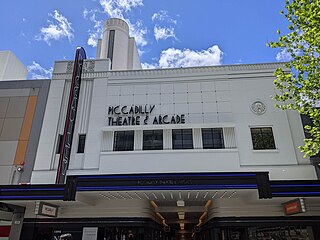
Mount Lawley is an inner northern suburb of Perth, Western Australia. The suburb is bounded by the Swan River to the east, Vincent, Harold and Pakenham Streets to the south, Central Avenue and Alexander Drive to the north, and Norfolk Street to the west.

A cygnet is a young swan.

Thomas George Anstruther Molloy was an Australian politician. He was a member of the Western Australian Legislative Assembly for the electorate of Perth from 1892 until 1894, and thereafter became a perennial candidate, unsuccessfully standing for parliament 14 times. He also served two terms as the Mayor of Perth, from 1908 to 1909 and from 1911 to 1912. Molloy also made a significant contribution to the cultural life of Perth, building numerous hotels and the first two theatres in the city, most notably His Majesty's Theatre, which is still open today.

The former Plaza Theatre in Sydney, New South Wales is a heritage-listed building designed as a 2000-seat cinema by Eric Heath for the Hoyts Group, and opened in 1930. It is no longer used as a cinema.

The Astor Theatre is located at 659 Beaufort Street, Mount Lawley, Western Australia. It comprises a single, two and three-storey masonry inter-war Art Deco style theatre and retail building.
William Garnsworthy Bennett was a Western Australian architect, well known for his Art Deco and Inter-War Functionalist style of civic, commercial and domestic buildings, including the Lord Forrest Olympic Pool in Kalgoorlie, the Beverley Town Hall, the Raffles Hotel and Plaza Theatre and Arcade in Perth.
William Thomas Leighton (1905–1990) was a Western Australian architect, well known for his Art Deco and Inter-War Functionalist style of civic, commercial and domestic buildings.

Grand Cinemas and Ace Cinemas are independent Western Australian chains of cinema multiplexes. The chains formerly co-operated under The Movie Masters banner, but as of 2022 they no longer operate under this arrangement.

The Piccadilly Cinema Centre and Piccadilly Arcade are located at 700-704 Hay Street, Perth, Western Australia. It is an art deco style cinema and shopping arcade, designed by architect William T. Leighton for mining entrepreneur Claude de Bernales. The theatre and arcade opened in 1938, with the arcade connecting Hay Street through to Murray Street.

The Perth tramway network served Perth, the capital city of Western Australia, from 1899 until 1958. The network was initially run by a private company but was taken over by the state government in 1913. From a single line along Hay Street, the network expanded north as far as Osborne Park, east as far as Welshpool, south as far as Como, and west as far as Claremont. The tramways were gradually replaced by buses after World War II.

The Windsor Cinema is located at 98 Stirling Highway, Nedlands, Western Australia. It is an Art Deco cinema designed by the architect William T. Leighton and constructed in 1937. It is currently leased by Luna Palace Cinemas.

Luna Leederville is a cinema complex located at the corner of Oxford and Vincent Streets in Leederville, a suburb of Perth, Western Australia.

The former Plaza Theatre is located at 650–658 Hay Street, Perth, Western Australia. It was the first purpose-designed Art Deco cinema in Perth. The Plaza Theatre opened in 1937 and was built for Hoyts Theatres Ltd.

The Oriana Cinema was an art deco cinema and theatre built in 1938 in Fremantle, Western Australia and demolished in the early 1970s.

The Ritz Cinema, also known as the Ritz Theatre, is a heritage-listed cinema located at 43 St Pauls Street, in the Sydney suburb of Randwick in the City of Randwick local government area of New South Wales, Australia. It was designed by Aaron Bolot and built in 1937 by C. & B. J. Williams. It was added to the New South Wales State Heritage Register on 2 April 1999. The architect, Aaron Bolot, is known for his classic art deco buildings throughout Sydney, such as his commissions for grand apartment buildings in Potts Point.
The Grand Theatre was a theatre and cinema located at 164–168 Murray Street, Perth, Western Australia. It was opened in September 1916 and closed in November 1980. The building was demolished in March 1990.

Henry Eli White, also known as Harry White, was a New Zealand-born architect best known for the many theatres and cinemas he designed in New Zealand and Australia in the 1910s and 1920s. Many of the major surviving historic venues in the two countries are White designs, including the St. James Theatre, Wellington, St. James Theatre, Auckland, the Capitol Theatre and State Theatre in Sydney, and the Palais Theatre and the interiors of the Princess Theatre and Athenaeum Theatre in Melbourne. He also designed the City Hall and the attached Civic Theatre in Newcastle, New South Wales.
The Theatre Royal and Metropole Hotel is a heritage-listed building in Perth, Western Australia, located at 637–645 Hay Street. Both the hotel and the theatre were built by businessman Thomas Molloy, completed in 1893 and 1897 respectively.















